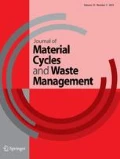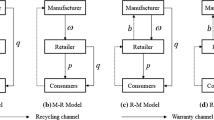Abstract
Different deposit–refund systems are being practically applied to promote the proper treatment of end-of-life products in China. One is widely used in the industry of household appliances nationwide (DR1) while the other is applied in the industry of electric vehicle (EV) in Shenzhen of China (DR2). It is found that both the deposit–refund entity (either manufacturers or retailers pay tax and receive subsidy) and the channel leadership are different between the two industries. Given the practical conditions, this study aims to comprehensively analyze the influence of the two deposit–refund systems under different channel leaderships. In this end, a game-theoretic model consisting of a manufacturer, a retailer and consumers is established and three channel leaderships including Nash game, M-leader, R-leader are considered. This study presents the collection rate, the total environmental impact and the economic benefit of the whole supply chain as multi-criteria to value the performance of the supply chain. The results indicate that different channel leaderships lead to different channel performances regardless of with DR1 or DR2. The study then explores and confirms the optimal deposit–refund system under each channel leadership. The results further demonstrate the advantages of practically applying the two different deposit–refund systems in China.






Similar content being viewed by others
References
Baidya R, Debnath B, Ghosh SK, Rhee SW (2019) Supply chain analysis of e-waste processing plants in developing countries. Waste Manage Res 38:173–183. https://doi.org/10.1177/0734242X19886633
Cucchiella F, D’Adamo I, Koh SL, Rosa P (2015) Recycling of WEEEs: an economic assessment of present and future e-waste streams. Renew Sustain Energy Rev 51:263–272. https://doi.org/10.1016/j.rser.2015.06.010
Palmer K, Walls M (1997) Optimal policies for solid waste disposal: taxes, subsidies, and standards. J Public Econ 65:193–205. https://doi.org/10.1016/S0047-2727(97)00028-5
Sigman H (1995) A comparison of public policies for lead recycling. Rand J Econ 26(3):452–478. https://doi.org/10.2307/2555998
Walls M (2011) Deposit-refund systems in practice and theory. Resources for the Future. https://media.rff.org/documents/RFF-DP-11-47.pDR. Accessed 3 Apr 2020.
CHEARI (2018) White paper on WEEE recycling industry in China (2017) (in Chinese). http://www.weee-epr.org/article/detail_133.html. Accessed 9 Mar 2020.
Gree (2017) The dismantling of waste electrical and electronic products in the second quarter of 2017 (in Chinese). http://recycle.gree.com/mall/ActivityContentDisplayView?catalogId=10051&langId=-7&storeId=11651&espotName=huodong10. Accessed 15 Apr 2020.
Li X, Mu D, Du J, Cao J, Zhao F (2020) Game-based system dynamics simulation of deposit-refund scheme for electric vehicle battery recycling in China. Resour Conserv Recycl 157:104788. https://doi.org/10.1016/j.resconrec.2020.104788
Tang Y, Zhang Q, Li Y, Wang G, Li Y (2018) Recycling mechanisms and policy suggestions for spent electric vehicles’ power battery-a case of Beijing. J Clean Prod 186:388–406. https://doi.org/10.1016/j.jclepro.2018.03.043
Choi T, Li Y, Xu L (2013) Channel leadership, performance and coordination in closed loop supply chains. Int J Prod Econ 146:371–380. https://doi.org/10.1016/j.ijpe.2013.08.002
Hoyt CL, Blascovich J (2003) Transformational and transactional leadership in virtual and physical environments. Small Group Res 34(6):678–715. https://doi.org/10.1177/1046496403257527
Defee CC (2007) Supply Chain Leadership. PhD Dissertation, University of Tennessee. https://core.ac.uk/download/pdf/268770917.pdf
Schul PL, Pride WM, Little TL (1983) The impact of channel leadership behavior on intrachannel conflict. J Mark 47(3):21–34. https://doi.org/10.2307/1251194
Majumder P, Srinivasan A (2008) Leadership and competition in network supply chains. Manage Sci 54(6):1189–1204. https://doi.org/10.1287/mnsc.1070.0752
Almehdawe E, Matin B (2010) Vendor managed inventory with a capacitated manufacturer and multiple retailer: retailer versus manufacturer leadership. Int J Prod Econ 128(1):292–302. https://doi.org/10.1016/j.ijpe.2010.07.029
Gao J, Han H, Hou L, Wang H (2016) Pricing and effort decisions in a closed-loop supply chain under different channel power structures. J Clean Prod 112:2043–2057. https://doi.org/10.1016/j.jclepro.2015.01.066
Fullerton D, Wolverton A (1997) The case for a two-part instrument presumptive tax and environmental subsidy. National Bureau of Economic Research. Working paper No. 5993. https://doi.org/10.3386/w5993
Lavee D (2010) A cost-benefit analysis of a deposit-refund program for beverage containers in Israel. Waste Manage 30:338–345. https://doi.org/10.1016/j.wasman.2009.09.026
Liu H, Wu X, Dou D, Tang X, Leong G (2018) Determining recycling fees and subsidies in China’s WEEE disposal fund with formal and informal sectors. Sustainability 10(9):2979. https://doi.org/10.3390/su10092979
Zhou G, Gu Y, Wu Y, Gong Y, Mu X, Han H, Chang T (2019) A systematic review of the deposit-refund system for beverage packaging: operating mode, key parameter and development trend. J Clean Prod 251:119660. https://doi.org/10.1016/j.jclepro.2019.119660
Fullerton D, Wu W (1998) Policies for green design. J Environ Econ Manag 36:131–148. https://doi.org/10.1006/jeem.1998.1044
Farber S (1991) Regulatory schemes and self-protective environmental risk control: a comparison of insurance, liability, and deposit/refund systems. Ecol Econ 3:231–245. https://doi.org/10.1016/0921-8009(91)90034-C
Hong IH, Ke J (2011) Determining advanced recycling fees and subsidies in “E-scrap” reverse supply chains. J Environ Manage 92:1495–1502. https://doi.org/10.1016/j.jenvman.2010.12.004
Hong IH, Lee Y, Chang P (2014) Socially optimal and fund-balanced advanced recycling fees and subsidies in a competitive forward and reverse supply chain. Resour Conserv Recycl 82:75–85. https://doi.org/10.1016/j.resconrec.2013.10.018
Numata D (2009) Economic analysis of deposit–refund systems with measures for mitigating negative impacts on suppliers. Resour Conserv Recycl 53:199–207. https://doi.org/10.1016/j.resconrec.2008.11.008
Numata D (2011) Optimal design of deposit–refund systems considering allocation of unredeemed deposits. Environ Econ Policy Stud 13:303–321. https://doi.org/10.1007/s10018-011-0018-y
Karakayali I, Emir-Farinas H, Akcal E (2007) An analysis of decentralized collection and processing of end-of-life products. J Oper Manag 25(6):1161–1183. https://doi.org/10.1016/j.jom.2007.01.017
Jafari H, Hejazi SR, Rasti-Barzoki M (2017) Sustainable development by waste recycling under a three-echelon supply chain: A game-theoretic approach. J Clean Prod 142:2252–2261. https://doi.org/10.1016/j.jclepro.2016.11.051
Savaskan RC, Bhattacharya S, Wassenhove LNV (2004) Closed-loop supply chain models with product remanufacturing. Manage Sci 50:239–252. https://doi.org/10.1287/mnsc.1030.0186
Giovanni P, Zaccour G (2014) A two-period game of a closed-loop supply chain. Eur J Oper Res 232:22–40. https://doi.org/10.1016/j.ejor.2013.06.032
Liu Z, Nishi T (2019) Government regulations on closed-loop supply chain with evolutionarily stable strategy. Sustainability 11(18):5030. https://doi.org/10.3390/su11185030
Wei J, Zhao J (2015) Pricing and remanufacturing decisions in two competing supply chains. Int J Prod Res 53(1):258–278. https://doi.org/10.1080/00207543.2014.951088
Hong X, Govindan K, Xu L, Du P (2017) Quantity and collection decisions in a closed-loop supply chain with technology licensing. Eur J Oper Res 256:820–829. https://doi.org/10.1016/j.ejor.2016.06.051
EC (European Commission) (2012) Directive 2012/19/EC of the European Parliament and of the Council on Waste Electrical and Electronic Equipment (WEEE). https://doi.org/10.3000/19770677.L_2012.197.eng. Accessed 8 June 2020.
Ministry of the Environment (2015) Action plan for the collection rate target achievement of the specified household equipment waste (in Japanese). https://www.env.go.jp/recycle/kaden/gaiyo.html. Accessed 18 Jan 2021
NDRC (National Development and Reform Commission) (2019) Interim measures for the management of lead-acid battery recycling (in Chinese). http://www.gov.cn/xinwen/2019-08/14/5421270/files/c709aace6c274fa088431f19362834bb.pdfb. Accessed 9 May 2020.
Ismail H, Hanafiah MM (2019) An overview of LCA application in WEEE management: current practices, progress and challenges. J Clean Prod 232:79–93. https://doi.org/10.1016/j.jclepro.2019.05.329
Liu Z, Tang J, Li B, Wang Z (2017) Trade-off between remanufacturing and recycling of WEEE and the environmental implication under the Chinese Fund Policy. J Clean Prod 167:97–109. https://doi.org/10.1016/j.jclepro.2017.08.137
Acknowledgements
The authors would like to express their sincere thanks to the program of “Akita University Doctoral Education Leading Program”.
Funding
The work presented in this paper was supported by grant from the Education Department of Henan Province, China (Project No. 20A790010).
Author information
Authors and Affiliations
Corresponding author
Additional information
Publisher's Note
Springer Nature remains neutral with regard to jurisdictional claims in published maps and institutional affiliations.
Supplementary Information
Below is the link to the electronic supplementary material.
Rights and permissions
About this article
Cite this article
Wang, J., Li, W., Nozomu, M. et al. Closed-loop supply chain under different channel leaderships: considering different deposit–refund systems practically applied in China. J Mater Cycles Waste Manag 23, 1765–1776 (2021). https://doi.org/10.1007/s10163-021-01234-3
Received:
Accepted:
Published:
Issue Date:
DOI: https://doi.org/10.1007/s10163-021-01234-3




